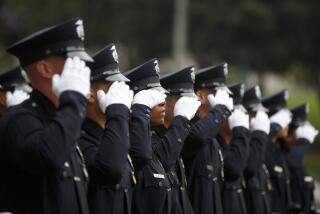The Spreading Blue Line : To Keep Officers Fit, Police Agencies Copy a San Diego Program
- Share via
SAN DIEGO — Four times a year, hundreds of San Diego police officers converge in the parking lot of Jack Murphy Stadium here, stretch out on royal blue mats and engage in a mass tangle of grunts and groans.
But not by choice.
Since October, 1988, five years after a citizens task force recommended fitness as a way to keep police from getting shot, officers have been asked to follow a regular exercise regimen and health program.
A year later, it became mandatory, and those who repeatedly failed could eventually lose their jobs.
It might seem natural for law enforcement agencies to set up fitness programs to build strength and endurance, just as they set guidelines for firearms proficiency. But the San Diego Police Department is one of the few in the state that forces officers to do sit-ups, pushups and running after they graduate from the academy.
Increasingly, however, as the nation becomes more health-conscious, many departments in the state are looking to San Diego as a model.
The Los Angeles Police Department, which abandoned fitness testing in 1979, has resurrected a plan similar to San Diego’s; it is to be part of labor negotiations this year.
For the first time, the state Commission on Peace Officer Standards and Training has created a voluntary fitness program, with the same cardiovascular and muscular strength tests San Diego uses. It will be the first standardized exercise exam ever available for law enforcement agencies.
Police departments from Fullerton and Long Beach to Redlands have inquired about San Diego’s FIT program--Fitness, Image, Training. So have sheriff’s departments in Los Angeles, Riverside and Contra Costa counties, and police departments from around the country.
“From our perspective, it’s for the safety of the community and the officer,” said Paul Schmidt, an exercise physiologist for the San Diego Police Department. “The more fit they are, the better they can do the job.”
Even Police Chief Bob Burgreen, 53, who admits he has had a weight problem for years, has gone through the program and passed the test, although he opts to walk three miles rather than run a mile and a half.
“Last time I took the test, I got an 83,” said the 220-pound Burgreen, who is up 40 pounds from several years ago. “I would like to have my weight down. If it weren’t for (the fitness program), I might not get any exercise at all.”
Departments with fitness programs rank in the minority. In a 1985 study, the Commission on Peace Officer Standards and Training found that 22.8% of 333 sheriff’s and police departments had a fitness program. Of the 76 agencies with programs, only 45 were mandatory. The numbers have not increased substantially since then.
That is changing, however.
“Law enforcement is finally identifying the fact that fitness programs do have a carry-over into job performance,” said Bob Rogers, supervisory special agent for the FBI’s physical training unit in Quantico, Va.
“There has never been as much interest in fitness in law enforcement as there is now,” said Rogers, who has taught dozens of fitness trainers for other agencies during the last 11 years.
Police labor unions have resisted attempts to establish exercise programs, arguing that the ability to do a set number of pushups or sit-ups has little to do with everyday police work.
“I’d like to have a program,” said San Diego County Sheriff Jim Roache. “But when someone who is 5-foot-3 and 280 pounds who is a great investigator asks why it’s important that he be able to do three pushups, how do you respond?”
Unions often reject mandatory programs, fearing for their members’ job security.
“One of the reasons it’s atypical to have a program is that it becomes an issue of collective bargaining,” said John G. Berner, bureau chief in Sacramento for the state Commission on Peace Officer Standards and Training. “If you make it a condition of employment, there’s a chance that someone might lose his job.”
Schmidt, who administers FIT, calls the regimen a moderate exercise program.
For example, a male officer 27 to 31 must do a minimum of 43 pushups and 47 sit-ups within two minutes each. Those between 20 and 29 must also run a mile and a half in no more than 13 minutes and 24 seconds. The requirements for women are slightly easier. Younger staff members must do more, older ones less.
When San Diego’s program was created in 1988, the average department score was 80 out of a possible 100 points. Of the 1,500 officers who took the test, 8.3% failed. By last summer, the average score was up to 87.5 and the failures were down to 1.8%.
“This is not a fitness-for-duty test,” Schmidt said, adding that no one has been fired from the San Diego police force for fitness failure. “This is a program to maintain health and fitness. We used to have five heart attacks a year in this department. We had none (last) year.”
Equally demanding is the California Highway Patrol’s program, which offers bonuses for those who do well and job loss for those who consistently fail.
The CHP’s test, administered annually, includes a bike-pedaling exercise, a long jump, a sidestep test, an upper-body strength test and a measure of trunk strength.
If any part of the test is failed, it can be taken four more times before an officer can be recommended for termination, according to Officer Susan Ward, the CHP’s physical performance coordinator.
The CHP started its program two years after it discovered that between 1973 and 1980, work-related disabilities increased nearly 200%.
The Los Angeles Police Department once had a program, but budget cuts helped to scuttle it more than a decade ago. Sgt. Greg Dossey, the department’s physical fitness coordinator, has submitted a new voluntary health plan, which includes bench presses, rowing, abdominal crunches, flexing exercises and other tasks.
Agencies without programs recite a familiar refrain: Is there any correlation between the number of pushups and sit-ups an officer can do and the ability to perform police duties?
“Once this gets into court, you’ll have someone say, ‘We’ve got officers who can’t run, much less walk, getting commendations and being loved by one and all,’ ” said Dossey. “ ‘How can you tell us our plaintiff is unfit for work when for 10 years he’s been injured less and had fewer days off than anyone?’ ”
More to Read
Sign up for Essential California
The most important California stories and recommendations in your inbox every morning.
You may occasionally receive promotional content from the Los Angeles Times.










